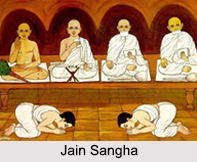 Jain Sangha is a four-fold community of Sadhus or ascetics and Sadhvis or nuns and Sravakas or male lay followers and Sravikas or female lay followers. Since whole Jain community is split into four categories it is called as the "Chaturvidha Sangha". The Sangha is thus a well organized unit or a "Tirth". Thus in simple terms, one who establishes a Tirtha or Sangha is a Tirthankara. The Jain sangha was founded as early as the 6th century B.C.
Jain Sangha is a four-fold community of Sadhus or ascetics and Sadhvis or nuns and Sravakas or male lay followers and Sravikas or female lay followers. Since whole Jain community is split into four categories it is called as the "Chaturvidha Sangha". The Sangha is thus a well organized unit or a "Tirth". Thus in simple terms, one who establishes a Tirtha or Sangha is a Tirthankara. The Jain sangha was founded as early as the 6th century B.C.
The Sravaka Sangha and the Sadhu Sangha are interdependent. The Sravakas look to all of the needs of the sadhus, while the Sadhu via his discourses shows the right path to the Sravakas. In case of difference of opinion between the two, the Sadhu Sangha voluntarily accepts the control of the Sravaka Sangha. In the same way the Sravaka Sangha too readily accepts the control of the Sadhu Sangha. Both of them thus with mutual interdependence and co-operation, work together for the welfare of the community.
Rules in Jain Sangha
In Jainism, there are rules prescribed for the Sadhus and Sravakas. Both of them are required to follow the same code of conduct. The Sadhus need to observe them rigorously whereas, the householders observe them partially. This is because the householders have to shoulder many socio-economic responsibilities.
The Sangha of Lord Mahavira came up with some very much needed reforms. It framed rules about life, mutual behavior and the duties that needed to be carried out by one and all.
The Vratas or vows prescribed for the sadhus are called "Mahavratas" or great vows which need to be meticulously and perfectly practiced by the monks and nuns, while those t be observed by the house-holder, are called "Anuvratas" or small or partial vows.
Duties of Sadhus and Sadhvis
The duties of Sadhus and Sadhvis aims to attain liberation form cycles of birth and death but, they are also given the additional duty to lead Sravakas on the path of salvation.
Duties of Sravakas and Sravikas
Mutual consent and co-ordination of ascetics and lay people are important for smooth functioning of Jain community. The several duties of Sravakas and Sravikas are as follows:
1. Attempt for Salvation - listen to sermons of ascetics, understand, discuss and clear doubts if any and follow the path of liberation.
2. Responsibility towards Sadhus - Sravaka and Sravika are the mother and father of Sadhus. On taking Diksha, Sadhu leaves family, home, town and relatives. On their journey, the Sravakas have responsibility to ensure prescribed space, food and water and clothes for them. They shall accompany them in Gochari and Vihar. Over and above this Sravaka is supposed to provide best medical care for them.
3. Watch the conduct of Sadhus - Sravakas and Sravikas have been entrusted with the task of watching and warning Sadhus for their conduct as specified by scripture. They need to keep distance from money, opposite sex and popular ways of fame and unwarranted other philosophies, astrology and fund raising activities.
4. Care of Religious Places - Sravakas in co-ordination with Sadhus take care of religious places.
According to the Jain texts, the sangha will be maintained till the very end of the present time. With the end of the sangha, the dharma (religion) will also end.




















